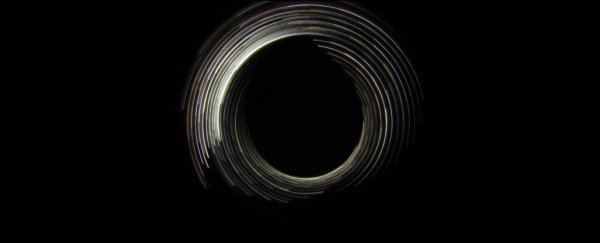The epic collision between two neutron stars in 2017 really is the science gift that keeps on giving. As they merged, gravitational waves rippled out across the Universe; now reverberations from that event could confirm a decades-old hypothesis about black holes.
Astronomers poring over the gravitational wave data believe they have found evidence of echoes - something that would only occur in the presence of the 'quantum fuzz' produced by Hawking radiation.
"According to Einstein's theory of general relativity, nothing can escape from the gravity of a black hole once it has passed a point of no return, known as the event horizon," said astronomer and physicist Niayesh Afshordi of the University of Waterloo in Canada.
"This was scientists' understanding for a long time until Stephen Hawking used quantum mechanics to predict that quantum particles will slowly leak out of black holes, which we now call Hawking radiation."
The most famous property of black holes is their extreme gravitational power. It's so intense that, under general relativity, once something strays closer than the point called the event horizon, nothing can achieve escape velocity. Not even the fastest thing in the Universe - electromagnetic radiation - can escape.
But quantum mechanics can explain details of the Universe in ways general relativity can't; according to an idea Hawking put forward in 1974, a black hole does emit something when you add quantum mechanics. This is a theoretical type of electromagnetic radiation called, fittingly, Hawking radiation.
This theoretical emission appears similar to the spectrum of light produced by heated objects, obeying the rules of black-body radiation, only in this case it's the black hole's super heavy mass causing the emission of super low-energy waves.

The existence of this radiation would mean that black holes are slowly evaporating, solving the black hole information paradox; but, just as gravitational waves were until just a scant few years ago, it's heretofore been too faint to detect.
Lab-made black hole analogues have definitely seemed to suggest that Hawking radiation is real. But gravitational waves could change that. Because if Hawking radiation is real, there should be quantum 'fuzz' around the outside of the event horizon of a black hole; and that fuzz should produce gravitational wave echoes.
"Scientists have been unable to experimentally determine if any matter is escaping black holes until the very recent detection of gravitational waves," said Afshordi.
"If the quantum fuzz responsible for Hawking radiation does exist around black holes, gravitational waves could bounce off of it, which would create smaller gravitational wave signals following the main gravitational collision event, similar to repeating echoes."
This is what Afshordi and his colleague, cosmologist Jahed Abedi of the Max Planck Institute for Gravitational Physics in Germany, believe they could have detected in the gravitational data. Their results, they say, match the simulated echoes predicted by models of fuzzy black holes emitting Hawking radiation.
But there are a few caveats. For one, an analysis last year of the gravitational wave data from GW 150914 - the first gravitational wave detection - found no evidence of Hawking radiation.
In addition, another study last year made a concerted analysis of all the gravitational wave signals collected to date, searching for evidence of gravitational wave echoes and, by extension, Hawking radiation. It found "no statistically significant evidence" for echoes.
It's entirely possible, in fact, that our instruments still aren't sensitive enough to detect Hawking radiation. And Afshordi acknowledges that the signal the team detected could actually just be noise in the data.
The way to find out would be to look for similar signals in other gravitational wave datasets.
"Now that scientists know what we're looking for, we can look for more examples, and have a much more robust confirmation of these signals," Afshordi said.
"Such a confirmation would be the first direct probe of the quantum structure of space-time."
The research has been published in the Journal of Cosmology and Astroparticle Physics.
